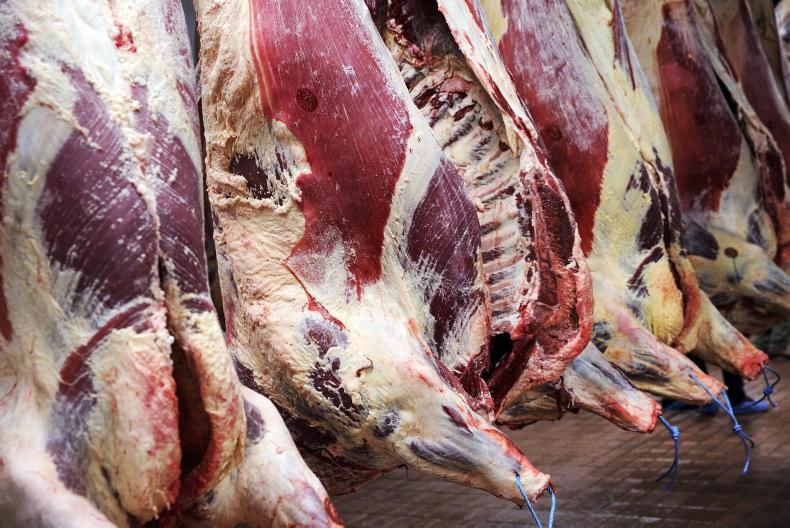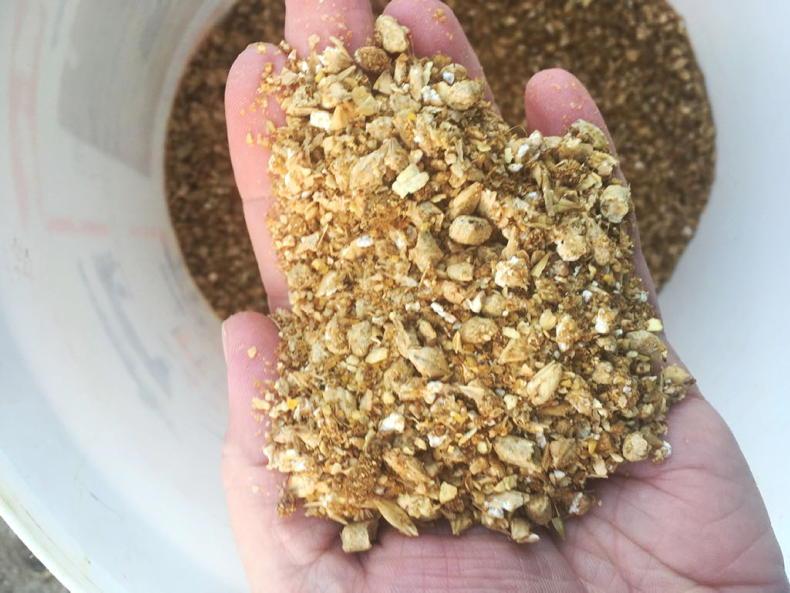Supplies of shed finished cattle are tightening and with beef prices hovering around the 450p/kg mark, there will be some farmers considering finishing animals off grass this summer.
However, a strong beef price on its own does not automatically equate to high levels of profits on cattle slaughtered.
Where farmers are contemplating killing cattle off grass in the coming weeks, they should firstly consider the pros and cons and complete a finishing budget to see if there is a profit to made.
There is no point working for nothing, and for herds that are not under movement restrictions, the live ring is returning strong prices for good-quality forward stores at the moment.
As such, for farmers that normally struggle to negotiate with factory agents for higher prices, cashing in forward stores now may be more profitable compared with finishing cattle off grass.
Taking the time to complete a budget now will allow farmers to make an informed decision at the outset.
Inputs
Outside of beef price, there are other factors to keep in mind. Ration prices look set to rise again in July, with some feed mills hinting at a £10 to £20/t price hike.
The availability of grass also needs to be taken in to consideration. Is there enough ground available to carry forward stores over the summer?
Also, with nitrogen currently in the region of £650/t, will fertiliser have to be purchased to keep grass growth in line with the animal’s grazing demand?
High-quality grass is required to finish cattle with minimal concentrate input. There is no place for grazing finishing cattle on low-quality, headed-out swards.
Fertiliser is up by £400/t on last summer and rations are up by close on £200/t, which is why the economics of grass finishing have to be considered carefully from the outset.
The prospect of a beef price around 450p/kg appears attractive, but will it be cover inputs and leave a margin?
Completing a finishing budget for cattle
As an example of completing a finishing budget, take a farmer with 20 heifers currently weighing 600kg. The heifers are 100% continental breeding and have U grade conformation.
The farmer is planning to feed rolled barley to the heifers at grass for a six-week period to get the animals to the desired fat cover for slaughter.
But before doing so, the farmer is keen to work out whether there will be a return on feeding the cattle for the outlined period or if the group is better off sold live now.
Starting value
The starting point is to put a value on the cattle at the outset. The mart trade is extremely strong for short keep cattle with U grade animals typically making 260p to 280p/kg.
If the heifers were sold over the next week through the live ring, at a conservative 260p/kg and 600kg liveweight, the animals are worth £1,560/head.
Finishing costs
Assuming the heifers are rotationally grazed on good-quality grass, the farmer plans to feed 2kg/day of rolled barley to the heifers for six weeks.
Barley is purchased at current market prices of £390/t on farm. Over the 42-day finishing period, each heifer consumes 84kg of barley costing £33/head.
The 20 heifers are grazing a 15 acre platform which will get one bag/acre of CAN to maintain grass growth. This works out at 0.75t of fertiliser, which at a purchase price of £650/t equates to £24/head.
Miscellaneous costs of £20 are factored in for items such as diesel used when spreading fertiliser and for tasks like topping grass.
Break-even
The outlined inputs come to £77 as summarised in Table 1. This should be added to the value of heifers sold through the live ring (£1,560) at the outset of the finishing period, bringing the break-even price to £1,637.
Assuming the heifers perform well at grass and have a final liveweight of 650kg, at 55% kill-out, the animals will have an average carcase weight of 358kg.
This means that at the outlined inputs and potential live trade value, the finished heifers need a breakeven beef price of 457p/kg.
This is before factoring in any profit margin. To make a modest £40/head margin from finishing the heifers, at the outlined carcase weight, this adds 11p/kg to the breakeven beef price.
In this scenario, the farmer would be better off selling the heifers now rather than finishing off grass at the end of July.
Sensitivity analysis
Allowing for some sensitivity analysis, reducing the value of the heifers sold in the live ring by 10p to 250p/kg lowers the breakeven price, before any profit margin, by 16p/kg. Equally, increasing the sale value by 10p/kg to 270p/kg adds 16p/kg to the breakeven price.
Every £10/t change in barley costs alters the breakeven price by 3p/kg, while reducing the £40 profit margin to £20/head lowers breakeven beef price by 6p/kg.
The outlined exercise is an example of completing a simple budget to determine if there is a margin finishing cattle off grass.
Every farm is different and, as such, the economics change with individual situations.
The point of the exercise is to do the sums now, then make the right decision.
Over the past couple of weeks, the beef trade has settled around 450p/kg in Northern Ireland and in Britain.
For the example farm, the outlined finishing costs would mean the farmer is better off selling top-quality stock now if they struggle to negotiate for higher prices.
However, if the farmer had plainer cattle that were capable of achieving similar carcase weights, the economics would look different.
Several processors have returned to the old tactics of talking the market down in an effort to reduce beef prices.
Completing a budget now should safeguard farmers against such moves. If the economics don’t stack up at current beef prices close to 450p/kg, the decision will be even more clear-cut if processors do pull prices next month.
Read more
Dairy management: soil moisture deficits creep up
How much did the average farmer spend on inputs in 2021?
Supplies of shed finished cattle are tightening and with beef prices hovering around the 450p/kg mark, there will be some farmers considering finishing animals off grass this summer.
However, a strong beef price on its own does not automatically equate to high levels of profits on cattle slaughtered.
Where farmers are contemplating killing cattle off grass in the coming weeks, they should firstly consider the pros and cons and complete a finishing budget to see if there is a profit to made.
There is no point working for nothing, and for herds that are not under movement restrictions, the live ring is returning strong prices for good-quality forward stores at the moment.
As such, for farmers that normally struggle to negotiate with factory agents for higher prices, cashing in forward stores now may be more profitable compared with finishing cattle off grass.
Taking the time to complete a budget now will allow farmers to make an informed decision at the outset.
Inputs
Outside of beef price, there are other factors to keep in mind. Ration prices look set to rise again in July, with some feed mills hinting at a £10 to £20/t price hike.
The availability of grass also needs to be taken in to consideration. Is there enough ground available to carry forward stores over the summer?
Also, with nitrogen currently in the region of £650/t, will fertiliser have to be purchased to keep grass growth in line with the animal’s grazing demand?
High-quality grass is required to finish cattle with minimal concentrate input. There is no place for grazing finishing cattle on low-quality, headed-out swards.
Fertiliser is up by £400/t on last summer and rations are up by close on £200/t, which is why the economics of grass finishing have to be considered carefully from the outset.
The prospect of a beef price around 450p/kg appears attractive, but will it be cover inputs and leave a margin?
Completing a finishing budget for cattle
As an example of completing a finishing budget, take a farmer with 20 heifers currently weighing 600kg. The heifers are 100% continental breeding and have U grade conformation.
The farmer is planning to feed rolled barley to the heifers at grass for a six-week period to get the animals to the desired fat cover for slaughter.
But before doing so, the farmer is keen to work out whether there will be a return on feeding the cattle for the outlined period or if the group is better off sold live now.
Starting value
The starting point is to put a value on the cattle at the outset. The mart trade is extremely strong for short keep cattle with U grade animals typically making 260p to 280p/kg.
If the heifers were sold over the next week through the live ring, at a conservative 260p/kg and 600kg liveweight, the animals are worth £1,560/head.
Finishing costs
Assuming the heifers are rotationally grazed on good-quality grass, the farmer plans to feed 2kg/day of rolled barley to the heifers for six weeks.
Barley is purchased at current market prices of £390/t on farm. Over the 42-day finishing period, each heifer consumes 84kg of barley costing £33/head.
The 20 heifers are grazing a 15 acre platform which will get one bag/acre of CAN to maintain grass growth. This works out at 0.75t of fertiliser, which at a purchase price of £650/t equates to £24/head.
Miscellaneous costs of £20 are factored in for items such as diesel used when spreading fertiliser and for tasks like topping grass.
Break-even
The outlined inputs come to £77 as summarised in Table 1. This should be added to the value of heifers sold through the live ring (£1,560) at the outset of the finishing period, bringing the break-even price to £1,637.
Assuming the heifers perform well at grass and have a final liveweight of 650kg, at 55% kill-out, the animals will have an average carcase weight of 358kg.
This means that at the outlined inputs and potential live trade value, the finished heifers need a breakeven beef price of 457p/kg.
This is before factoring in any profit margin. To make a modest £40/head margin from finishing the heifers, at the outlined carcase weight, this adds 11p/kg to the breakeven beef price.
In this scenario, the farmer would be better off selling the heifers now rather than finishing off grass at the end of July.
Sensitivity analysis
Allowing for some sensitivity analysis, reducing the value of the heifers sold in the live ring by 10p to 250p/kg lowers the breakeven price, before any profit margin, by 16p/kg. Equally, increasing the sale value by 10p/kg to 270p/kg adds 16p/kg to the breakeven price.
Every £10/t change in barley costs alters the breakeven price by 3p/kg, while reducing the £40 profit margin to £20/head lowers breakeven beef price by 6p/kg.
The outlined exercise is an example of completing a simple budget to determine if there is a margin finishing cattle off grass.
Every farm is different and, as such, the economics change with individual situations.
The point of the exercise is to do the sums now, then make the right decision.
Over the past couple of weeks, the beef trade has settled around 450p/kg in Northern Ireland and in Britain.
For the example farm, the outlined finishing costs would mean the farmer is better off selling top-quality stock now if they struggle to negotiate for higher prices.
However, if the farmer had plainer cattle that were capable of achieving similar carcase weights, the economics would look different.
Several processors have returned to the old tactics of talking the market down in an effort to reduce beef prices.
Completing a budget now should safeguard farmers against such moves. If the economics don’t stack up at current beef prices close to 450p/kg, the decision will be even more clear-cut if processors do pull prices next month.
Read more
Dairy management: soil moisture deficits creep up
How much did the average farmer spend on inputs in 2021?










SHARING OPTIONS